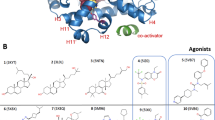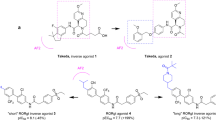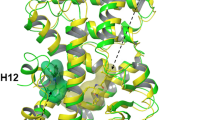Abstract
The nuclear retinoid receptors RARs and RXRs are transcriptional regulators whose activity is mediated by their ligand-binding domain. The crystal structures of the unliganded human (apo) hRXRa ligand-binding domain and of the all-trans retinoic acid-liganded (holo) hRARγ ligand-binding domain have been described. We report the crystal structures of the hRARγ ligand-binding domain bound to either its other natural ligand 9-cis retinoic acid, or an RARγ-selective synthetic agonist (BMS961). The two bound RA stereoisomers exhibit a striking structural resemblance, as their intrinsic flexibility allows them to fit into a unique ligand-binding pocket. The shape of BMS961 is a combination of those of the natural ligands and an additional RARγ-specific hydrogen bond is responsible for the RARg isotype selectivity. All three agonist molecules fill almost entirely the ligand cavity and lead to an identical holo-ligand-binding domain protein conformation, thus accounting for their similar effect on RAR transactivation. The selectivity of different RAR ligands can now be explained using BMS961 as a template. The present conclusions are not limited to RARγ and can be extended to the other members of the retinoid family.
This is a preview of subscription content, access via your institution
Access options
Subscribe to this journal
Receive 12 print issues and online access
$189.00 per year
only $15.75 per issue
Buy this article
- Purchase on Springer Link
- Instant access to full article PDF
Prices may be subject to local taxes which are calculated during checkout
Similar content being viewed by others
References
Mangelsdorf, D.J. et al. Cell 83, 835–839 (1995).
Chambon, P. FASEB. J. 10, 940–954 (1996).
Gronemeyer, H. & Laudet, V. Protein Profile. 2, 1173–1308 (1995).
Bourguet, W., Ruff, M., Chambon, P., Gronemeyer, H. & Moras, D. Nature 375, 377–382 (1995).
Renaud, J.P. et al. Nature 378, 681–689 (1995).
Taneja, R. et al. Proc. Natl. Acad. Sci. USA 93, 6197–6202 (1996).
Swann, R.T., Smith, D., Tramposch, K.M. & Zusi, F.C. U. S. Patent #5,624,957; 4/29/97 (1997).
Chen, J.Y. et al. Nature 382, 819–822 (1996).
Wurtz, J.M. et al. Nature Struct. Biol. 3, 87–94 (1996).
Dawson, M.I. et al. Cancer Res. 55, 4446–4451 (1995).
Bernard, B.A. et al. Biochem. Biophys. Res. Commun. 186, 977–983 (1992).
Charpentier, B. et al. J. Med. Chem. 38, 4993–5006 (1995).
Graupner, G. et al. Biochem. Biophys. Res. Commun. 179,1554–1561 (1991).
Allenby, G. et al. Proc. Natl. Acad. Sci. USA 90, 30–34 (1993).
Allegretto, E.A. et al. J. Biol. Chem. 268, 26625–26633 (1993). [Published erratum appears in J. Biol. Chem. 269, 7834; (1994)].
Lehmann, J.M. et al. Science 258, 1994–1946 (1992).
Dawson, M.I. et al. J. Med. Chem. 38, 3368–3383 (1995).
Bouillon, R., Okamura, W.H. & Norman, A.W. Endocr. Rev. 16, 200–257 (1995).
Brzozowski, A.M. et al. Nature 389, 753–758 (1997).
Rochel, N. et al. Biochem. Biophys. Res. Commun. 230, 293–296 (1997).
Bhat, T.N.J. Appl. Crystallogr. 21, 279–281 (1988).
Brünger, A.T. X-PLOR Version 3.851.Yale University Press (1996).
Brünger, A.T. Nature 355, 472–474 (1992).
Laskowski, R.A., MacArthur, M.W., Moss, D.S. & Thornton, J.M.J. Appl. Crystallogr. 26, 283–291 (1993).
Kabsch, W.J. Appl. Crystallogr. 21, 916–924 (1988).
Collaborative Computational Project, Number 4 The CCP4 Suite: Programs for Protein Crystallography. Acta Crystallogr. D50, 760–763 (1994).
Jones, T.A., Zou, J.Y., Cowan, S.W. & Kjeldgaard, M. Acta Crystallogr. A. 47, 110–119 (1991).
Evans, S.V. J. Mol. Graphics 11, 134–138 (1993).
Author information
Authors and Affiliations
Corresponding author
Rights and permissions
About this article
Cite this article
Klaholz, B., Renaud, JP., Mitschler, A. et al. Conformational adaptation of agonists to the human nuclear receptor RARγ. Nat Struct Mol Biol 5, 199–202 (1998). https://doi.org/10.1038/nsb0398-199
Received:
Accepted:
Issue Date:
DOI: https://doi.org/10.1038/nsb0398-199
This article is cited by
-
CONFIRM: connecting fragments found in receptor molecules
Journal of Computer-Aided Molecular Design (2008)
-
RAR and RXR modulation in cancer and metabolic disease
Nature Reviews Drug Discovery (2007)
-
Design of selective nuclear receptor modulators: RAR and RXR as a case study
Nature Reviews Drug Discovery (2007)
-
β-arrestin 2 modulates the activity of nuclear receptor RAR β2 through activation of ERK2 kinase
Oncogene (2006)
-
Principles for modulation of the nuclear receptor superfamily
Nature Reviews Drug Discovery (2004)



